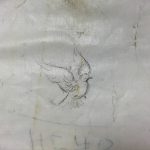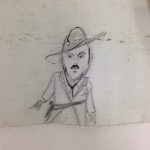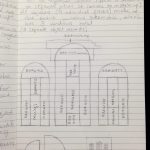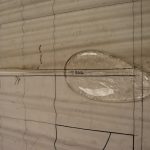This post comes from Laura Hashimoto and Bonnie Hodul, Rakow Library interns who are helping conserve the Whitefriars stained glass cartoon collection over the summer. Read more about this project and the collection in previous posts.
In May 2016, we began our contribution to the efforts jointly led by the Rakow Research Library and West Lake Conservators to treat the Whitefriars collection of stained glass window cartoons and photographs. The Whitefriars collection’s conservation involves the surface cleaning, humidification and flattening, tear mending and stabilization, digitization, and condition/treatment documentation of approximately 1,800 rolls, comprised of an estimated 10,000 individual objects. We are very excited to work with and treat a small selection of these objects this summer.
Lucky for us, our first roll contained only a single paper object, which fit perfectly on our arranged set of tables.

Single object from our first roll for St. Alban’s Church, England.
Our second roll, however, proved to have 16 individual waxed canvases for St. Vedast Church in London, England, whose “small” objects we estimated to be about the length of one of our wingspans!

Laura prepares a waxed canvas object for humidification.
With backgrounds in paper conservation and photograph preservation, these waxed canvases were new territory for us. The canvas substrate (or, the surface layer that underlies an object such as a drawing) appeared frequently in the collection, so West Lake Conservators’ decided to perform sampling for analysis in order to better understand the composition of these canvases. Dr. H.F. (Gus) Shurvell, Adjunct Professor in Art Conservation and Emeritus Professor of Chemistry at Queen’s University in Canada, performed Fourier Transform Infrared Spectroscopy to obtain an infrared (IR) spectrum of the sampled canvas. The individual spectra were compared to a database of known samples, which allowed Dr. Shurvell to determine that the canvases are a varied mix of cotton, flax, or linen with a starch, and their wax impregnation is beeswax! Analyzing samples such as this requires expertise and experience, and thanks to Dr. Shurvell and West Lake Conservators, we now have a much better understanding of the materials present in these cartoons, which informs treatment procedure and object handling.

Dr. Shurvell compared the unknown samples with known samples of beeswax, cotton and starch, shown in the image above. The two peaks of the unknown sample (red) line echo the two peaks of the beeswax (black) line on the left, and its broad band on the right matches the cotton and starch samples. Other matches were also found with linen and flax, not shown in this graph.
#NeedMoreTables quickly began trending in the Preservation Lab. There was no color and very few distinguishing features evident on the drawings themselves, but we found character in small yet detailed sketches in the margins of the canvases!
The canvases are to the scale of the final stained glass windows, and would have been used as part of the working process. Glass would have been laid on top of the objects and cut, and lead would have then been used to attach the glass pieces together. Once installed, the glass was painted and, in this case, this is where most of the detail for the windows was realized.
Once we wrapped our heads around the sheer size of the objects, we began to decipher the working notations, which were evident on almost all of the objects. After coincidentally re-aligning three objects that had been cut and separated as part of the stained glass window working process, we began to quite literally, see the bigger picture.

Laura photographs three waxed canvases that fit together as part of a larger section of one of the windows.
From looking at the technical jargon labelling the various “lights,” or individual windows, to being able to line up cut marks that earlier were obscured by some soiling or staining, we “shrunk” the 15 to 20-foot long cartoons to put them into perspective with a schematic diagram. Fortunately, the overall shapes of the windows were indicated by a small rendering of the final installation!
- A sketch from Bonnie’s notebook as she pieced together the different canvases, each assigned a “BIB” reference number for the Library, into a full schematic of how all sixteen canvases fit together to form the entire set of three windows in St. Vedast Church.
- Glass weights holding together two objects where they align.
- A drawing made to be inserted into each condition report for the objects, showing where the individual canvas fits into the entire scene.
This was truly an exciting discovery for us, and is something that the materials and working process can contribute to the interpretation of the objects. The 16 objects have taken over a month to treat, as their size has challenged everything from the space available in the lab to our available supplies. While challenging, working with these waxed canvases that were an integral part of the process for the St. Vedast Church windows has been awe-inspiring.

Bonnie holds one end of a 15-foot-long canvas, one of the largest in the roll! The two largest canvases are approximately 21 feet.

These are the windows at St. Vedast Church that the canvases were used to help create. Photo by DAVID ILIFF. License: CC-BY-SA 3.0.
Follow the progress of the project and learn more about our interns, Laura and Bonnie.
The Rakow Research Library is open to the public 9am to 5pm every day. We encourage everyone to explore our collections in person or online. If you have questions or need help with your research, please use our Ask a Glass Question service.





